Treatment of trigeminal ganglion neurons in vitro with NGF, GDNF or BDNF: effects on neuronal survival, neurochemical properties and TRPV1-mediated neuropeptide secretion
- PMID: 15667652
- PMCID: PMC548274
- DOI: 10.1186/1471-2202-6-4
Treatment of trigeminal ganglion neurons in vitro with NGF, GDNF or BDNF: effects on neuronal survival, neurochemical properties and TRPV1-mediated neuropeptide secretion
Abstract
Background: Nerve growth factor (NGF), glial cell line-derived neurotrophic factor (GDNF) and brain-derived neurotrophic factor (BDNF) all play important roles in the development of the peripheral sensory nervous system. Additionally, these growth factors are proposed to modulate the properties of the sensory system in the adult under pathological conditions brought about by nerve injury or inflammation. We have examined the effects of NGF, GDNF and BDNF on adult rat trigeminal ganglion (TG) neurons in culture to gain a better understanding of how these growth factors alter the cytochemical and functional phenotype of these neurons, with special attention to properties associated with nociception.
Results: Compared with no growth factor controls, GDNF, at 1 and 100 ng/ml, significantly increased by nearly 100% the number of neurons in culture at 5 days post-plating. A significant, positive, linear trend of increasing neuron number as a function of BDNF concentration was observed, also peaking at nearly 100%. NGF treatment was without effect. Chronic treatment with NGF and GDNF significantly and concentration-dependently increased 100 nM capsaicin (CAP)-evoked calcitonin gene-related peptide (CGRP) release, reaching approximately 300% at the highest concentration tested (100 ng/ml). Also, NGF and GDNF each augmented anandamide (AEA)- and arachidonyl-2-chloroethylamide (ACEA)-evoked CGRP release, while BDNF was without effect. Utilizing immunohistochemistry to account for the proportions of TRPV1- or CGRP-positive neurons under each growth factor treatment condition and then standardizing evoked CGRP release to these proportions, we observed that NGF was much more effective in enhancing CAP- and 50 mM K+-evoked CGRP release than was GDNF. Furthermore, NGF and GDNF each altered the concentration-response function for CAP- and AEA-evoked CGRP release, increasing the Emax without altering the EC50 for either compound.
Conclusions: Taken together, our results illustrate that NGF, GDNF and BDNF differentially alter TG sensory neuron survival, neurochemical properties and TRPV1-mediated neuropeptide release in culture. In particular, our findings suggest that GDNF and NGF differentially modulate TRPV1-mediated neuropeptide secretion sensitivity, with NGF having a much greater effect on a per neuron basis than GDNF. These findings are discussed in relation to possible therapeutic roles for growth factors or their modulators in pathological pain states, especially as these relate to the trigeminal system.
Figures

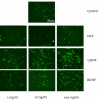


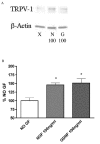
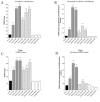

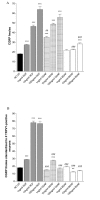
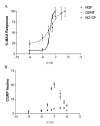


Similar articles
-
Modulation of trigeminal sensory neuron activity by the dual cannabinoid-vanilloid agonists anandamide, N-arachidonoyl-dopamine and arachidonyl-2-chloroethylamide.Br J Pharmacol. 2004 Apr;141(7):1118-30. doi: 10.1038/sj.bjp.0705711. Epub 2004 Mar 8. Br J Pharmacol. 2004. PMID: 15006899 Free PMC article.
-
Acute and chronic effects of neurotrophic factors BDNF and GDNF on responses mediated by thermo-sensitive TRP channels in cultured rat dorsal root ganglion neurons.Brain Res. 2009 Aug 11;1284:54-67. doi: 10.1016/j.brainres.2009.06.014. Epub 2009 Jun 12. Brain Res. 2009. PMID: 19524560
-
A role for the anandamide membrane transporter in TRPV1-mediated neurosecretion from trigeminal sensory neurons.Neuropharmacology. 2005 Jul;49(1):25-39. doi: 10.1016/j.neuropharm.2005.01.031. Epub 2005 Apr 1. Neuropharmacology. 2005. PMID: 15992578 Free PMC article.
-
Current understanding of trigeminal ganglion structure and function in headache.Cephalalgia. 2019 Nov;39(13):1661-1674. doi: 10.1177/0333102418786261. Epub 2018 Jul 10. Cephalalgia. 2019. PMID: 29989427 Free PMC article. Review.
-
Regulation of nociceptive neurons by nerve growth factor and glial cell line derived neurotrophic factor.Can J Physiol Pharmacol. 2002 May;80(5):495-505. doi: 10.1139/y02-034. Can J Physiol Pharmacol. 2002. PMID: 12056559 Review.
Cited by
-
Multiple impairments of cutaneous nociceptor function induced by cardiotoxic doses of Adriamycin in the rat.Naunyn Schmiedebergs Arch Pharmacol. 2016 Sep;389(9):1009-20. doi: 10.1007/s00210-016-1267-x. Epub 2016 Jun 24. Naunyn Schmiedebergs Arch Pharmacol. 2016. PMID: 27342418
-
TRP Channels in the Focus of Trigeminal Nociceptor Sensitization Contributing to Primary Headaches.Int J Mol Sci. 2020 Jan 4;21(1):342. doi: 10.3390/ijms21010342. Int J Mol Sci. 2020. PMID: 31948011 Free PMC article. Review.
-
Spatio-temporal release of NGF and GDNF from multi-layered nanofibrous bicomponent electrospun scaffolds.J Mater Sci Mater Med. 2018 Jun 28;29(7):102. doi: 10.1007/s10856-018-6105-x. J Mater Sci Mater Med. 2018. PMID: 29955977 Free PMC article.
-
Effect of resuscitation after selective cerebral ultraprofound hypothermia on expressions of nerve growth factor and glial cell line-derived neurotrophic factor in the brain of monkey.Neurosci Bull. 2008 Jun;24(3):150-4. doi: 10.1007/s12264-008-1702-1. Neurosci Bull. 2008. PMID: 18500387 Free PMC article.
-
Activation of CB1 inhibits NGF-induced sensitization of TRPV1 in adult mouse afferent neurons.Neuroscience. 2014 Sep 26;277:679-89. doi: 10.1016/j.neuroscience.2014.07.041. Epub 2014 Aug 1. Neuroscience. 2014. PMID: 25088915 Free PMC article.
References
-
- Lewin GR, Mendell LM. Regulation of cutaneous C-fiber heat nociceptors by nerve growth factor in the developing rat. J Neurophysiol. 1994;71:941–949. - PubMed
Publication types
MeSH terms
Substances
Grants and funding
LinkOut - more resources
Full Text Sources
Other Literature Sources
Research Materials
Miscellaneous

